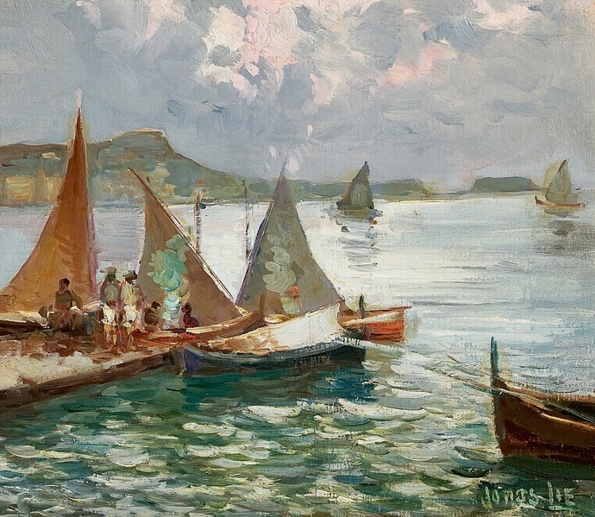
Digital Libraries and Initiatives

(above: Jonas Lie, Harbor Sails, oil on panel, 8.2 x 9.7 inches, Heritage Auctions, Dallas. Public domain, via Wikimedia Commons*)
Digital Libraries for Art Dealer Associations
A regional association of art dealers, or even a single art dealer, can develop a digital library accessible on the Web similar to the TFAO Digital Library. TFAO defines a digital library as a "integrated set of services for acquiring, cataloging, storing, searching, protecting, and retrieving information in a digital format. Digital libraries are a collection of a large number of digital records and files, comprising various types of material and media, that are organized, managed and stored in distributed information repositories and accessed through computers. Digital libraries can include converted media or original material produced for the World Wide Web."
When are dealers are asked what steps lead to superior business success, a constant reply is that education of prospective and current clients is a, if not the, crucial element. In order to facilitate education, art dealers can join together to create cost-effective processes of digitizing and placement of educational content on their individual websites and their association's website.
A digital library can be a very powerful means of driving Web traffic to an association's website. For an example of how large online traffic can grow over time, click here to see traffic statistics for TFAO's digital library.
Trends
Many museums are publishing on their websites digital images of art objects in their collections. When a museum creates a catalogue of digital images and descriptions of the art objects contained in its collection it is creating a significant part of a digital library.[1] Commercial online ventures are aggregating both image and text information on individual artists, which are made available to the public on either a pay-per-view or subscription basis. Except for sampler information, content is not available to viewers on an open access basis.
Materials converted from analog to digital media can include:
Museums, and some art dealers, are increasingly publishing onilne materials in audio, illustrated audio and video format. Other creative projects can be developed and placed in digital libraries.

(above: Robert Franklin Gates,
Market, 1936, 16.5 x 21.7 inches, Smithsonian American
Art Museum. Public domain, via Wikimedia Commons*)
Getting Started
TFAO suggests that members of art dealers associations:
Note:
1. The conversion of analog photos of art works to digital images, or original digital photography of art works, followed by cataloging and online assess, has been a focus of American museums and cooperative image libraries for several years. Examples of joint image repositories are ARTstor and AMICO Library. For texts, JSTOR is an archive of backfiles of traditional serials, excluding museum catalogue essays and other texts. Access to the contents of these three services is fee-based. Some museums are recently publishing on their web sites texts from contemporary exhibition catalogues, checklists and even PDF images of exhibition brochures and catalogues.
Go to
Note:
1. The conversion of analog photos of art works to digital images, or original digital photography of art works, followed by cataloging and online assess, has been a focus of American museums and cooperative image libraries for several years. Examples of joint image repositories are ARTstor and AMICO Library. For texts, JSTOR is an archive of backfiles of traditional serials, excluding museum catalogue essays and other texts. Access to the contents of these three services is fee-based. Some museums are recently publishing on their web sites texts from contemporary exhibition catalogues, checklists and even PDF images of exhibition brochures and catalogues.
![]() Return to Digital Libraries and Initiatives
Return to Digital Libraries and Initiatives
Links to sources of information
outside of our web site are provided only as referrals for your further
consideration. Please use due diligence in judging the quality of information
contained in these and all other web sites. Information from linked sources
may be inaccurate or out of date. TFAO neither recommends or endorses these
referenced organizations. Although TFAO includes links to other web sites,
it takes no responsibility for the content or information contained on those
other sites, nor exerts any editorial or other control over them. For more
information on evaluating web pages see TFAO's General Resources section in Online Resources for Collectors and Students of
Art History.
*Tag for expired US copyright of object image:

 Search Resource Library
Search Resource Library
Copyright 2022 Traditional Fine Arts Organization, Inc., an Arizona nonprofit corporation. All rights reserved.